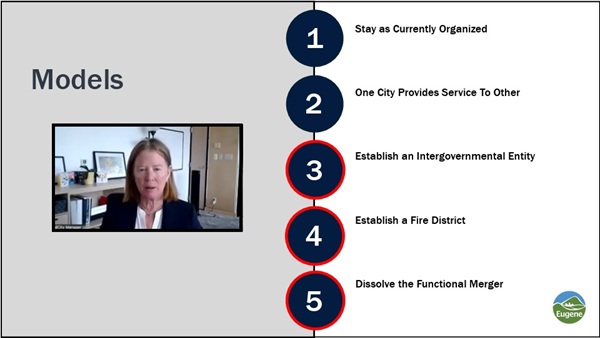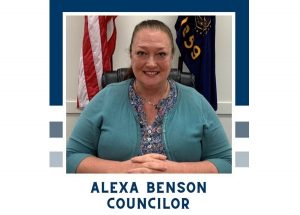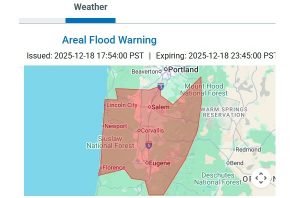Council learns more about an independent fire district
10 min read
Presenter: Springfield and Eugene firefighters train and respond under one fire chief, but that one fire chief has to deal with two mayors, two city councils, two IT departments, two HR departments, two city budgets, and two city managers. At the Eugene City Council Oct. 22, City Manager Sarah Medary:
Sarah Medary (Eugene, city manager): Imagine running a merged business where you still had two boards of directors, two CEOs, two CFOs, and on and on and on. This has been happening for over a decade.
[00:00:30] Presenter: Councilor Randy Groves:
[00:00:32] Councilor Randy Groves: And we were never intended to stay where we are now. It was always intended that it would be one system, regardless of what the form of governance was.
[00:00:40] I also want to thank Chief (Mike) Caven and his team for continuing to make this thing work even though it’s awkward and cumbersome, and I want to thank our firefighters for continuing to be professional and just always seem to be able to pull things together to make them work.
[00:00:57] Presenter: Councilor Mike Clark:
[00:00:58] Councilor Mike Clark: I think that the community knows their fire department and their fire chief have been working very long and very hard with a system that is not giving them the best support that they need in order to serve all of us the best way. And it is my belief that they need a single organization that manages them. They need the resources to do the job more effectively without having to scrimp and get by with things that are less than optimal for taking care of people’s health and safety. And it’s important for us to give them the structure that can provide that kind of support.
[00:01:44] Presenter: They’ve narrowed it down to two possible structures. Eugene City Manager Sarah Medary:
[00:01:49] Sarah Medary: We’ve done a lot of work on fire governance, and today I’m really focusing in on two areas, a new fire district and an intergovernmental entity.
[00:01:58] We brought in an outside consultant with a lot of experience in this area, AP Triton. They conducted many stakeholder interviews to include staff, elected officials, and union representatives.
[00:02:10] These are the outcomes they distilled from those conversations: ‘We’re looking for that future that is stable and predictable. Very important that our team has the ability to innovate and plan for the future, that we’re able to grow and ability to respond to that growth and that we have the resources to sustainably fund the department. Emergency services need to be proactively planned for and resourced. The best day to plan for your worst day is not the day after.’
[00:02:37] Presenter: The consultant examined five different models for governance.
[00:02:41] Sarah Medary: Their final recommendation indicated that an intergovernmental entity was most feasible as our next governance model.
[00:02:48] Since that time, there’s been a lot of discussion about the potential benefits of a new and independent fire district—a special district is what it’s called, a new form of government. So it’s a new general government that has its own separate elected body.
[00:03:02] Typically, they’re single-focus. So for example, you see like Willamalane or River Road, parks and recreation districts. They’re all funded by property tax. That’s their primary and sometimes only funding source. They’re typically rural.
[00:03:16] In Oregon, there’s really two ways—one is to form a new district which actually because of us being urban and not rural really doesn’t appear to be an option for us. So the second option is really to annex into an existing district.
[00:03:30] So today I’m going to focus in on the Willakenzie Rural Fire Protection District. It’s the only district that has a tax rate equal to or above what the AP Triton report recommended as a base.
[00:03:41] The Willakenzie Rural Fire Protection District has a permanent tax rate of approximately $3.07 per $1,000. The city of Eugene’s entire permanent rate is approximately $6.85 per $1,000.
[00:03:54] Presenter: She said the first question every single person brings up is about compression. Sarah Medary:
[00:04:00] Sarah Medary: Compression was introduced by Measure 5 in 1990 and it limits the rate of taxation. We’re focusing on the general government; $10 per $1,000 of real market value is a limit, a legal limit of what can be charged to any property.
[00:04:16] The total of all general governments currently and most of Eugene is basically $9.66 per thousand. As mentioned earlier, the Measure 5 cap on general government is $10 per $1,000.
[00:04:28] Our region has been really good about keeping our overall rates below $10. It’s been a longstanding value of the city of Eugene and our regional partners as evidenced in many presentations on levies to stay within the $10 cap, while Portland, on the other hand, hovers closer to $15, and this is why I think we need to talk about what could potentially happen. There were times where we would have been losing significant revenue. Those are taxes that wouldn’t be collected, and this is what people talk about being lost to compression.
[00:04:58] A good framework for looking at how compression might play out across the city and across development types is a countywide average of assessed value to real market value, for properties within the same classification.
[00:05:10] Residential multifamily housing are going to have the most room for growth and where taxes could go up the most. And as you move down into industrial and business property, more likely, on average, to be in compression and have revenue loss.
[00:05:28] And as a reminder, when we do talk about compression, what gets compressed first is the local option levies.
[00:05:34] Given all of that information, we estimate a new district with a permanent tax rate of $3.7 (per $1,000) would generate about $56.4 million annually.
[00:05:43] Presenter: She assumed that even though Eugene and Springfield would no longer be funding the fire department, the cities would not change their tax rates. Sarah Medary:
[00:05:54] Sarah Medary: Under my ‘maximum case scenario’ where no one’s voluntarily lowering the rates, the city of Eugene loses about $2.4 million. A lot of that is local option levies. Lane County, $1.75 (million). And also in compression in their first year in the Upper Willamette Soil and Water District.
[00:06:13] Other revenues, such as the community safety payroll tax, which the district employees would continue to pay to Eugene, but would not be receiving in revenue for their services. In other words, unless the city decided to voluntarily give a new government your payroll tax, the new government would have to fund that service with their property tax revenue.
[00:06:32] Our population, when you look at Eugene and Springfield together, we represent just under 74%. Our assessed value is over 76%. As you move from a city service to a regional service, the costs shift. And because of our higher AV (assessed) value, Eugene residents will pay more than a cost distributed by population.
[00:06:53] There’s a significant variation from property to property, creating a lot of disparity and inequities in how services are funded. Not a new issue, just one to be aware of.
[00:07:02] Presenter: She also reviewed the consultant’s recommendation, the intergovernmental entity. Similar to wastewater management, the IGE can charge fees.
[00:07:12] Sarah Medary: As you know, I’ve been an advocate of shifting our mindset and management of fire and EMS to more of a utility model. It’s a 24-7 operation you can’t shut off and our community depends on it, scaling with growth and need. It’s a service that needs a more proactive planning and approach.
[00:07:27] The fee is established by account holder, which is broader than property owner. As you might recall, fees are paid across the system and include properties that are exempt from property taxes, such as the city of Eugene, nonprofits, the U of O, etc. It’s based on square footage, which was considered to be an equitable way to look at the cost of fire services.
[00:07:47] Presenter: Former fire chief, Councilor Randy Groves:
[00:07:50] Councilor Randy Groves: Just to be clear, when we’re talking about the cost of a district, you are adding in additional revenue that’s needed for trying to catch up to the last 44 years where our growth has been stagnant, correct?
[00:08:07] Sarah Medary: I’m just showing you what that rate would generate across Eugene, and it would generate $12 million more than what we’re currently putting in general fund. That’s what I was trying to show. I don’t know, actually, if it’s enough to get above. It could potentially have to levy.
[00:08:25] Councilor Randy Groves: That’s what I was trying to get at, but it would help with the catch-up. And whatever we do, I mean, we need to take into account that our resources have not kept up with the pace of growth and the capacity limitations we’re experiencing.
[00:08:41] But for me, one of the things I will be looking at is some form of plan for catch-up. I don’t know that it all can be done in one year, but some way, regardless of the form of governance we end up with, that that happens.
[00:08:54] Do you have any sense of what the public’s appetite would be for this, or is that something we’re going to need to be doing some polling on?
[00:09:02] Sarah Medary: Yeah, I haven’t talked to the public at all about a district.
[00:09:07] Councilor Randy Groves: I don’t have a good feel for it myself, but I do know that when we were talking about the fire services fee, quite a few people that I spoke with at least said that they would support more money going to the fire department. But one of their complaints was a smaller percentage would actually be going to the fire department to help with the fact that we just haven’t had any growth to keep up with population growth.
[00:09:33] Presenter: Councilor Eliza Kashinsky:
[00:09:35] Councilor Eliza Kashinsky: Either of these options would involve setting up independent HR, IT, Finance support. And so under either of these, they wouldn’t have that same challenge where they’ve got two CFOs and two budgets they’ve got to do.
[00:09:50] Sarah Medary: Correct.
[00:09:51] Councilor Eliza Kashinsky: Okay. And then you talk about the member fees as part of the intergovernmental agency, is that like per person in Eugene? Eugene’s going to give us 10 bucks or whatever the number is, is that kind of how that works?
[00:10:05] Sarah Medary: Yeah, I think that’s how they imagined it. I called it ‘member fees’ because, you know, in an intergovernmental entity, and as Dan from AP Triton talked about, you create that entity and then it has the ability to grow over time. So if somebody else wanted to join, you could potentially talk about that. But yeah, it would be establishing that sort of base rate at which you’re doing your service.
[00:10:28] Presenter: Mayor Kaarin Knudson:
[00:10:30] Kaarin Knudson (Eugene, mayor): Do any of these governance structures affect our community’s protection from wildfire? Do any of these government structure decisions alone change how exposed or not exposed our community is to the risk of wildfire?
[00:10:45] Presenter: Fire Chief Mike Caven:
[00:10:47] Mike Caven (Eugene Springfield Fire, chief): Along with some of the other, you know, initiatives, the gap funding and the stations, whatever path we choose needs to account for future investment in the wildfire space as that changes and as we grow and develop the program.
[00:11:02] Right now, that program does receive funding from community safety payroll tax. And you know, plausibly within the IGE, we would keep that and have a new revenue stream to address future needs in that space.
[00:11:18] In either of those two options, there is the possibility for further collaboration with regional partners to strengthen wildfire. But again, that’s more down the road.
[00:11:30] So both of them provide an opportunity for that. I think the revenue structure that comes with an IGE might give us more flexibility in identifying, explaining, and selling that to the community.
[00:11:44] Presenter: Mayor Knudson:
[00:11:45] Kaarin Knudson (Eugene, mayor): The difference in number of assets, different ways that our two communities have invested over decades in this resource, how does that get captured into this process? Because I think the city of Eugene and city of Springfield, I think both of our communities try to live out our values in our decisions, but in some ways they’ve been really different over decades.
[00:12:08] Sarah Medary: Yeah, I won’t be able to answer that well today. I think that’s an area that we’re going to have to continue working on collectively. I think Springfield is scheduled to have this conversation mid-November-ish, and then we’ll come together to be able to provide more comprehensive discussion. But that’s a challenge, to be honest.
[00:12:29] No matter what you do, even if we stay a single department, you’re going to need to find more resources. In an IGE model, you could do that through a fee potential. You could do that through continuing to levy.
[00:12:42] We haven’t levied for Fire, but you could. Springfield does. I wouldn’t recommend a levy, and I mean, I guess when I get around to making a recommendation, a levy is time limited. It’s a five-year funding source, and if you want certainty in how you’re providing that service, I think you’d want a more steady stream.
[00:12:59] I intend to make a recommendation to you in December.
[00:13:03] Presenter: The Eugene City Council considers the two finalists for fire department governance. The consultant has previously recommended an intergovernmental entity, while firefighters support an independent fire district. Sarah Medary will offer a recommendation in her final month as city manager.
See also: Eugene to discuss independent fire district Oct. 22, which quotes Dan Petersen of AP Triton: “To address some of the compression and issues, both cities should probably reduce an equal amount in their collection, which could be challenging, but it’s an option that would best serve the community.”





